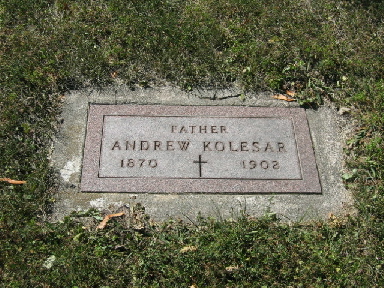 |
Minneapolis Pioneers and Soldiers Memorial Cemetery History Page Alley Article |
| Home | Burial Search | Friends | History | Photo Gallery | Visitor Information |
| Alley Articles |
|
This article originally appeared in the Phillips community's Alley Newspaper, July 2007.
When Andrew Kolesar died, the headline in the Minneapolis Tribune read “Bohemians Mourn for Their King.” The Minneapolis Journal, in its headline, referred to Kolesar as “The King of the Flats.” Two days later, after considerable public protest, the Tribune acknowledged that Kolesar, though well-liked, was not a king. If there was anyone who would have approved of that clarification it would have been Andrew Kolesar. Andrew Kolesar was born in Slovakia in 1870 and emigrated to the United States in 1891. He and his family settled on the Bohemian Flats below the Washington Avenue Bridge on the West Bank. Kolesar quickly adapted to life in Minneapolis and seemed to have an innate sense of how to navigate the City’s bureaucracy. He used his persuasive skills to give a voice to his disenfranchised fellow countrymen by advocating for them and when necessary intervening with city officials on their behalf. Most importantly, he educated them about which politicians best represented their interests, and he had the ability to get them out to vote. The idea that he was a “king” ran counter to the message that he was intent on delivering. Though he could not be considered a member of a royal family by any stretch of the imagination, he was clearly the most influential person living on the Bohemian Flats. His influence extended from politics to family disputes. According to the Tribune: “In politics the sway of the young man was unquestioned; in family disputes his word was high law; in a social way he was the lion; in business he was a careful and safe adviser.” Kolesar’s most important achievement was convincing voters on the Flats that their political interests were best represented by the Republican Party. The Flats had long been a Democratic stronghold, but Kolesar helped to change all of that. As a reward for his efforts he was appointed Assistant Fireman at the water works in Northeast Minneapolis. It was a prestigious job, one “befitted the king,” and generally viewed as safer than working as an unskilled laborer in one of the local mills. Andrew Kolesar was appointed to the highest position held by any Slovak immigrant in the City of Minneapolis. His dream job was not without risks, not least of which was coming into contact with contaminated water. Untreated water often carried the bacteria that caused typhoid fever, a leading cause of death in the early 1900s—over 800 people buried in Minneapolis Pioneers and Soldiers Memorial Cemetery died from typhoid. In early March of 1902, Andrew Kolesar contracted the disease and was admitted to Asbury Hospital. Two weeks later, on March 14, 1902, he died at the age of 32. When Andrew Kolesar died, residents of the Flats lost one of their most respected citizens. Despite that, the community of approximately 500 immigrant families continued to thrive on the West Bank near the Cedar-Riverside neighborhood. In the 1930s the City exercised its right of eminent domain and demolition of the houses began. Today the Flats are part of the Minneapolis Park system. A celebration of immigrants and their contributions to Minneapolis’ public life for the past 150 years will take place on the Flats on Saturday, August 18th from noon to 5 p.m. Please join us!
Next Article -> The Allen and Coonradt Families -- September 2007 |
|
©Friends of the Cemetery, 2005-2008 Contact us at history@friendsofthecemetery.org |
File last updated: Tuesday January 22, 2008 |
